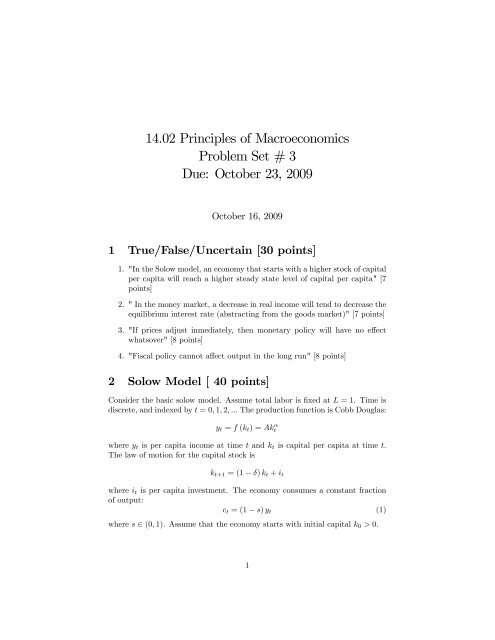14.02 Principles of Macroeconomics: Problem Set 3 - MIT ...
14.02 Principles of Macroeconomics: Problem Set 3 - MIT ...
14.02 Principles of Macroeconomics: Problem Set 3 - MIT ...
You also want an ePaper? Increase the reach of your titles
YUMPU automatically turns print PDFs into web optimized ePapers that Google loves.
<strong>14.02</strong> <strong>Principles</strong> <strong>of</strong> <strong>Macroeconomics</strong><br />
<strong>Problem</strong> <strong>Set</strong> # 3<br />
Due: October 23, 2009<br />
October 16, 2009<br />
1 True/False/Uncertain [30 points]<br />
1. "In the Solow model, an economy that starts with a higher stock <strong>of</strong> capital<br />
per capita will reach a higher steady state level <strong>of</strong> capital per capita" [7<br />
points]<br />
2. " In the money market, a decrease in real income will tend to decrease the<br />
equilibrium interest rate (abstracting from the goods market)" [7 points]<br />
3. "If prices adjust inmediately, then monetary policy will have no e¤ect<br />
whatsover" [8 points]<br />
4. "Fiscal policy cannot a¤ect output in the long run" [8 points]<br />
2 Solow Model [ 40 points]<br />
Consider the basic solow model. Assume total labor is …xed at L = 1. Time is<br />
discrete, and indexed by t = 0; 1; 2; ::: The production function is Cobb Douglas:<br />
y t = f (k t ) = Ak t<br />
where y t is per capita income at time t and k t is capital per capita at time t.<br />
The law <strong>of</strong> motion for the capital stock is<br />
k t+1 = (1<br />
) k t + i t<br />
where i t is per capita investment. The economy consumes a constant fraction<br />
<strong>of</strong> output:<br />
c t = (1 s) y t (1)<br />
where s 2 (0; 1). Assume that the economy starts with initial capital k 0 > 0:<br />
1
1. Show that equation (1) implies that per capita investment is also a constant<br />
fraction <strong>of</strong> per capita income. Which equation, which was not stated<br />
in the set up <strong>of</strong> this question, do you need to show this? [4 points]<br />
2. Using the previous result, state a law <strong>of</strong> motion for capital per capita.<br />
This is, an equation relating k t+1 to k t . [4 points]<br />
3. Compute the steady state capital per capita in this economy. Call it k.<br />
Also, compute the level <strong>of</strong> investment per capita (i) and income per capita<br />
(y) in the steady state. [6 points]<br />
4. We will now derive an analytical expression for the evolution <strong>of</strong> the per<br />
capita capital stock in this economy. Assume from now on that = 1,<br />
that is, that the capital stock fully depreciates in one period.<br />
(a) Write k 1 as a function <strong>of</strong> k 0 : [2 points]<br />
(b) Write k 2 as a function <strong>of</strong> k 1 , and, using (a), as a function <strong>of</strong> k 0 . [2<br />
points]<br />
(c) Write k 3 as a function <strong>of</strong> k 0 . [2 points]<br />
(d) Now, in light <strong>of</strong> the 3 previous answers, write an equation that generalizes<br />
to any t. That is, write k t as a function <strong>of</strong> k 0 for any t 0 1 .<br />
[7 points]<br />
(e) Show that the limit (as t ! 1) <strong>of</strong> the expression you just got is<br />
exactly k (the steady state level <strong>of</strong> capital derived in point 4). That<br />
is,<br />
P<br />
show lim t!1 k t = k. [Hint: Recall that for any constant x 2 (0; 1):<br />
1<br />
i=0 xi = 1<br />
1 x<br />
] [3 points]<br />
5. Using the analytical expression derived in point 5 (d), plot the evolution<br />
<strong>of</strong> the per capita capital stock in this economy. Take s = 0:2, A = 1,<br />
= 0:5 (and <strong>of</strong> course, = 1). That is, plot k t as a function <strong>of</strong> t. Do this<br />
graph for both the case in which k 0 = 1 and k 0 = 0:01:[10 points]<br />
3 IS-LM [30 points]<br />
Consider the following version <strong>of</strong> the IS-LM model, where expected in‡ation is<br />
zero ( e = 0). Assume net exports (NX) are zero.<br />
C = c 0 + c 1 (Y T )<br />
I = b 0 + b 1 Y b 2 i<br />
M d =P = d 1 Y d 2 i<br />
M s = M<br />
where all the variables are as de…ned in class, and T represents taxes.<br />
1 This procedure is called recursive substitution.<br />
2
1. Find the IS relation. What assumption on the parameters do we have<br />
to impose to ensure that the goods market reaches an equilibrium? Show<br />
graphically happens to this relation when taxes increase. [6 points]<br />
2. Derive the LM relation. What happens when M increases? Explain the<br />
intuition. [6 points]<br />
3. Find the short-run equilibrium (i.e. …nd the pair (Y; i) that makes the<br />
goods and money markets both be in equilibrium at the same time) [6<br />
points]<br />
4. What happens to equilibrium output and the interest rate as taxes increase?<br />
Use your results from the previous part, as well as the IS-LM<br />
graph to illustrate your answer. [6 points]<br />
5. What happens to equilibrium output and the interest rate as money supply<br />
increases? [6 points]<br />
3
<strong>MIT</strong> OpenCourseWare<br />
http://ocw.mit.edu<br />
<strong>14.02</strong> <strong>Principles</strong> <strong>of</strong> <strong>Macroeconomics</strong><br />
Fall 2009<br />
For information about citing these materials or our Terms <strong>of</strong> Use, visit: http://ocw.mit.edu/terms.

















